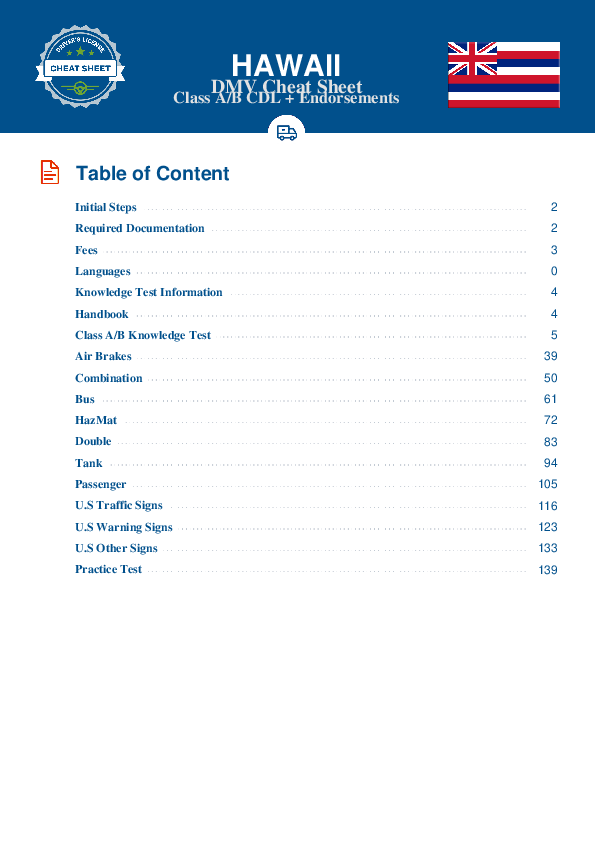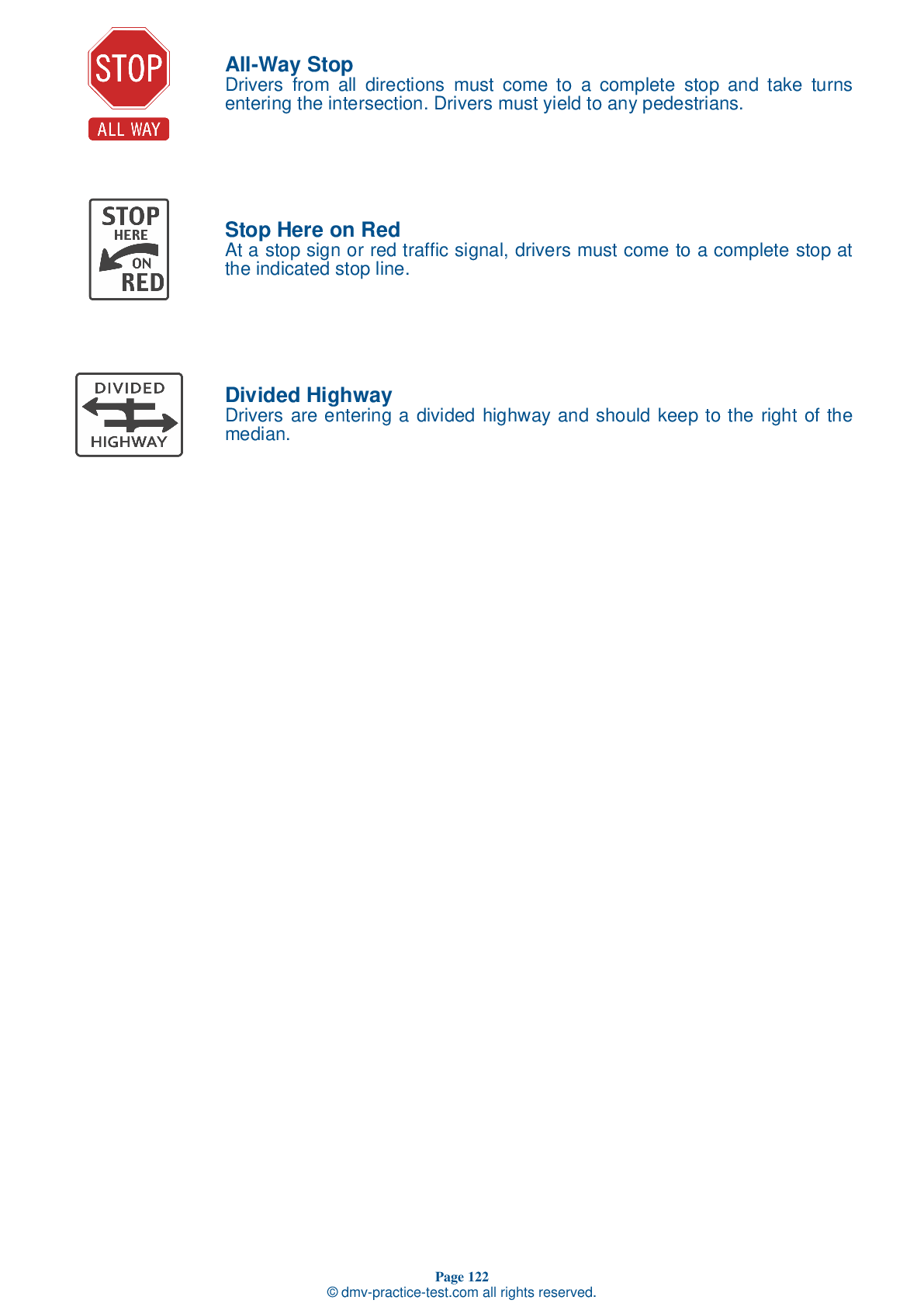Knowledge Test Class A #1
Class A Driving Test | Hawaii 2025 #1 Page 3 of 7
Train for FREE online with our Hawaii class A license test. The official exam test consists of several obligatory parts, with all of them checking your knowledge of different blocks of road rules. If you need to obtain a HI CDL class A permit in 2025, practice as much as possible. Free sample tests published on our website will help you check and improve your knowledge and boost your grades. Please bear in mind that CDL class A requirements may vary from state to state.
50
40
20
15 . Maintaining a cushion of space between your vehicle and the vehicle ahead is:
For safe driving, it is essential that you maintain cushions of space on all sides of your vehicle. This helps to ensure that you will have time to take appropriate action if a problem arises.
16 . In a dual air brake system, air pressure should build from 85 to 100 psi within ____ seconds.
When inspecting a vehicle with a dual air brake system, you should wait for air pressure to build from 85 to 100 psi in both the primary and secondary systems. This should take about 45 seconds.
17 . If a speed limit is posted, the posted speed:
A maximum posted speed limit is the fastest a vehicle may travel under ideal circumstances. A driver should decrease their driving speed as conditions require. A driver should never exceed the legal speed limit.
18 . During a static leakage test, what is the maximum leakage rate that is safe for a double combination vehicle?
When performing a static leakage test on a double combination vehicle with air brakes, the leakage rate should be no more than 3 psi in one minute. If the air leaks from the air brake system at a quicker rate, the vehicle should not be driven because something likely needs to be repaired.
19 . In a dual air brake system:
There are two air brake systems in a dual air brake system. The systems share a set of brake controls, but each system has its own tanks, hoses, and lines.
20 . What is the Gross Vehicle Weight Rating (GVWR)?
A Gross Vehicle Weight Rating (GVWR) is the value specified by the manufacturer as the loaded weight of a single vehicle.
21 . When exiting a vehicle, it is important to maintain ____ with your vehicle at all times.
As you exit your vehicle during the basic vehicle control skills test, you must face the vehicle and maintain three points of contact at all times. If your testing vehicle is a bus, you must maintain contact with the handrail. Exiting the vehicle incorrectly may result in automatic failure of the basic control skills test.
2025 Hawaii | Frequently Asked Questions
A Commercial Driver's License (CDL) Class B in Hawaii allows the holder to operate single vehicles with a Gross Vehicle Weight Rating (GVWR) of 26,001 pounds or more, or any such vehicle towing another not exceeding 10,000 pounds GVWR. This includes buses, farm labor vehicles, and any combination of vehicles not defined in Class A or Class C.
A Class B CDL license in Hawaii allows the holder to operate single vehicles with a Gross Vehicle Weight Rating (GVWR) of 26,001 pounds or more, and any such vehicle towing another not exceeding 10,000 pounds. Examples include straight trucks, large buses, segmented buses, box trucks, dump trucks with small trailers, and tractor-trailers.
To acquire a Class B CDL license in Hawaii, applicants must be at least 21 years old (18 for intrastate driving), possess a valid Hawaii driver's license, pass a vision test, and successfully complete both a knowledge test and a skills test. Applicants must also provide proof of U.S. citizenship or lawful permanent residency and meet medical requirements.
To qualify for a Class B CDL license in Hawaii, you must be at least 21 years old. This age requirement is standard across the United States and is set by the Federal Motor Carrier Safety Administration. It's important to meet this age requirement before beginning the process of obtaining a Class B CDL.
While not always required, specific endorsements may be necessary for a Class B CDL license in Hawaii depending on the type of vehicle you plan to operate or the cargo you will be transporting. Examples include a passenger endorsement for buses, a school bus endorsement for school buses, or a hazardous materials endorsement for transporting hazardous materials.
The Class B CDL skills assessment in Hawaii includes three parts: a pre-trip vehicle inspection to test your ability to assess the safe operation of the vehicle, a basic control skills test to evaluate your handling of the vehicle, and an on-road driving test to assess your ability to safely operate the vehicle in various traffic situations.
Yes, Class B CDL license holders in Hawaii are limited to driving single vehicles with a gross vehicle weight rating of 26,001 or more pounds, or any such vehicle towing a vehicle not exceeding 10,000 pounds. They are not allowed to drive a combination of vehicles (like a tractor-trailer) unless they hold a Class A CDL.
In Hawaii, the written Class B Commercial Driver's License (CDL) test is typically administered in English. However, some testing centers may offer the test in other languages. It's advised to contact your local testing center directly to inquire about language options. Remember, Federal regulations require all CDL holders to read and speak English proficiently.
Yes, you can request accommodations for the Class B CDL written exam in Hawaii if you have a disability. The specific process and types of accommodations available may vary, so it's best to contact the Hawaii Department of Transportation directly to discuss your needs and learn about the available options.
Yes, if you don't pass the Class B CDL written test in Hawaii, you can retake it. You must wait a minimum of one week before retesting. There may be a retesting fee, and if you fail three times, you'll need to start the application process over again. Always check with your local DMV for specific rules and regulations.



